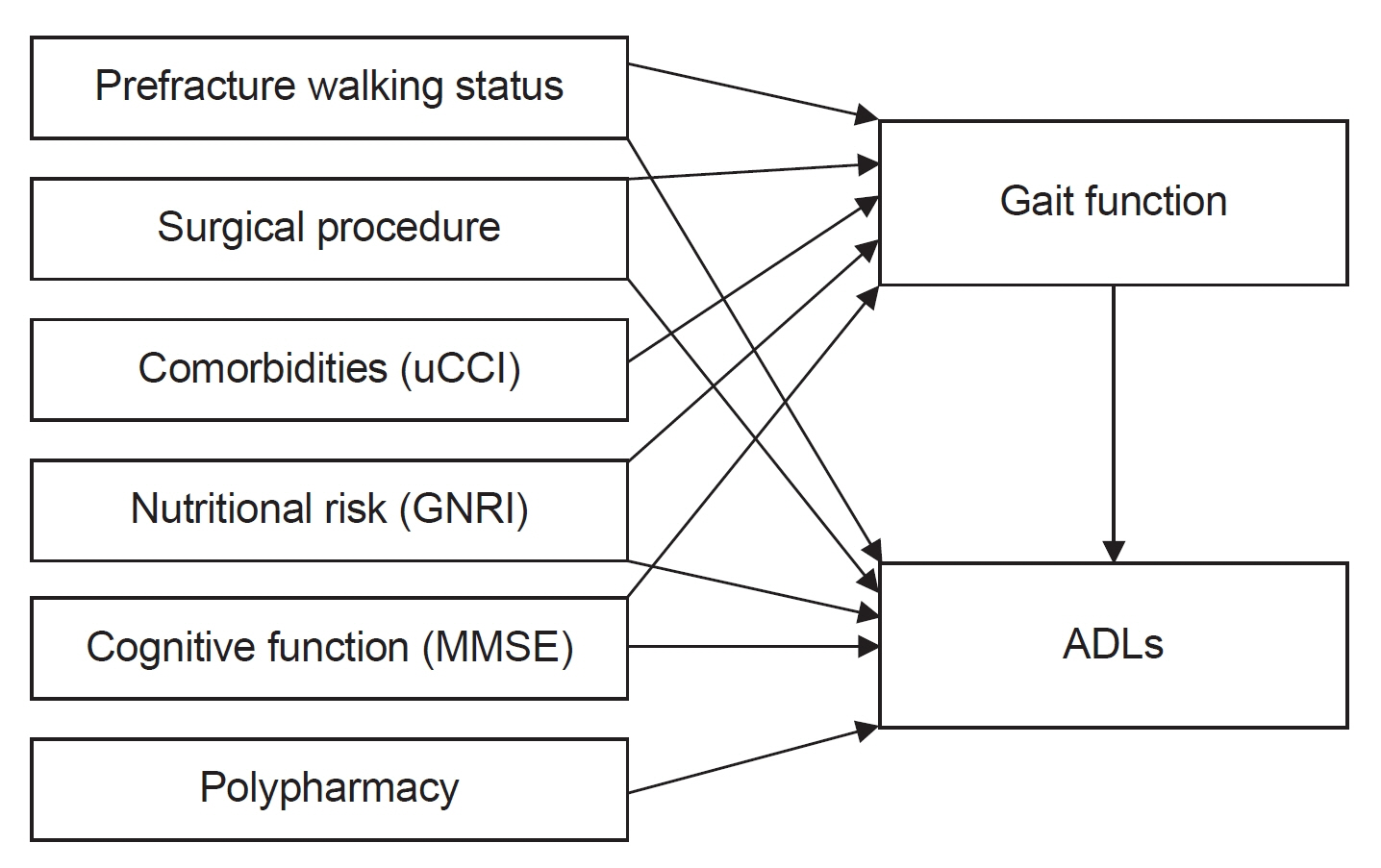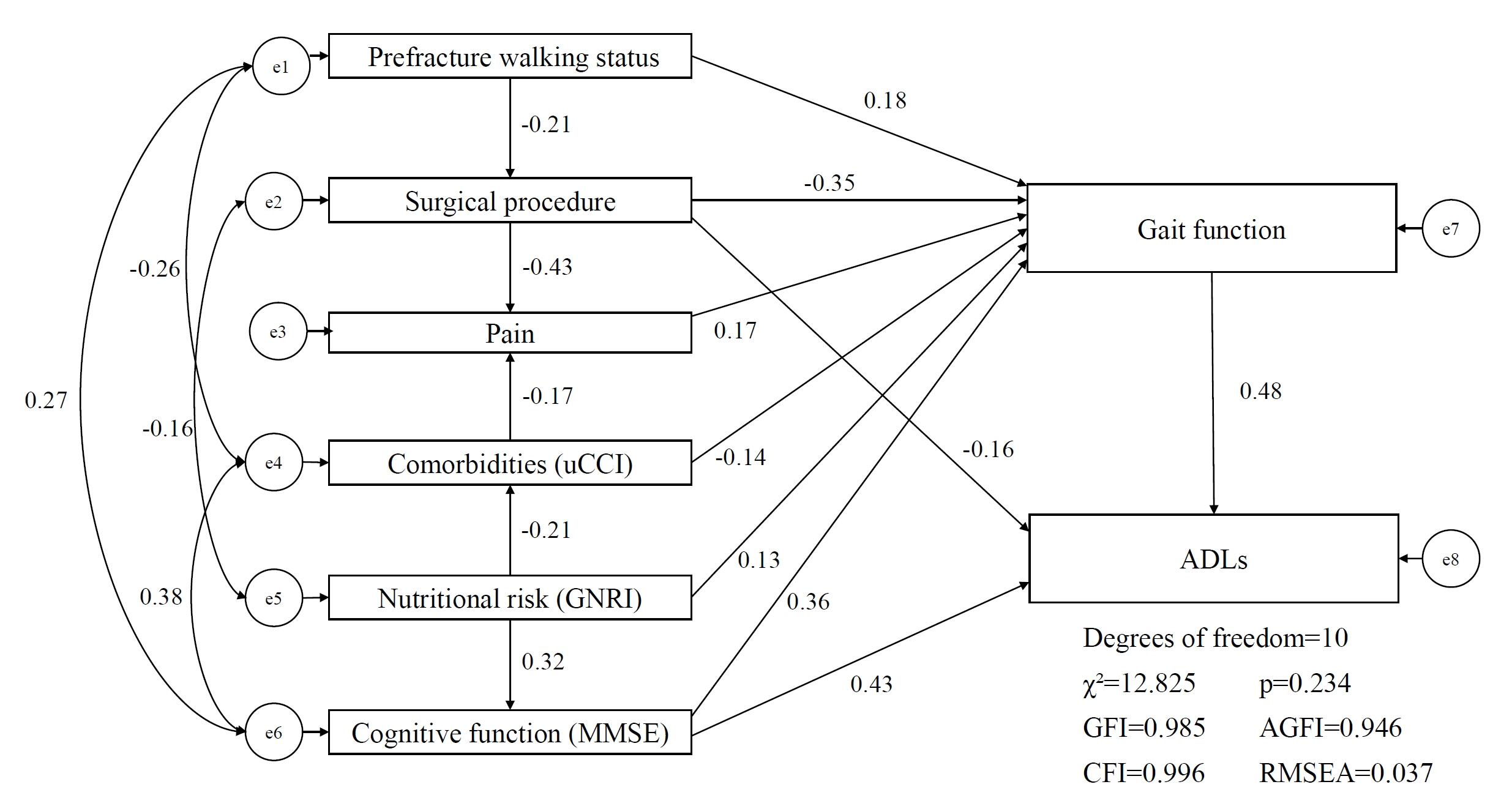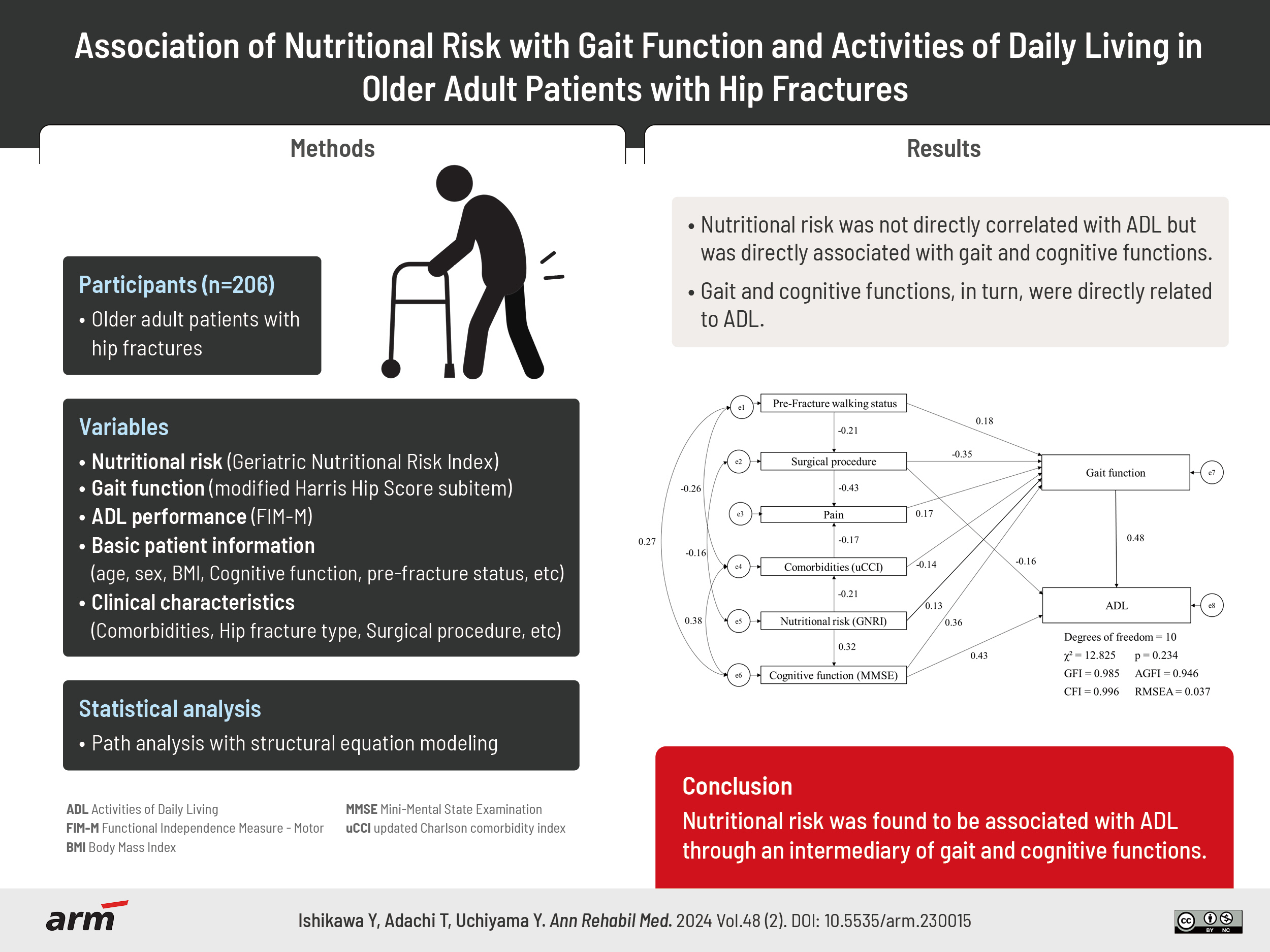Ann Rehabil Med.
2024 Apr;48(2):115-123. 10.5535/arm.230015.
Association of Nutritional Risk With Gait Function and Activities of Daily Living in Older Adult Patients With Hip Fractures
- Affiliations
-
- 1Department of Rehabilitation, Nishio Hospital, Nishio, Japan
- 2Division of Creative Physical Therapy, Field of Prevention and Rehabilitation Sciences, Graduate School of Medicine, Nagoya University, Nagoya, Japan
- KMID: 2554787
- DOI: http://doi.org/10.5535/arm.230015
Abstract
Objective
To investigate the association of nutritional risk with gait function and activities of daily living (ADLs) in older adult patients with hip fractures.
Methods
The retrospective data of older adult patients diagnosed with hip fractures who visited the recovery-phase rehabilitation ward between January 2019 and December 2022 were reviewed. Nutritional risk was evaluated using the Geriatric Nutritional Risk Index; gait function and ADLs were assessed using the modified Harris Hip Score subitem and Functional Independence Measure, respectively. Multivariate linear regression and path analysis with structural equation modeling were used to examine the factors associated with ADLs and the associations among the study variables.
Results
This study included 206 participants (172 females and 34 males; mean age, 85.0±7.3 years). In the multivariate analysis, gait function (β=0.488, p<0.001), cognitive function (β=0.430, p<0.001), and surgery (β=-0.143, p<0.001) were identified as independent factors. Pathway analysis revealed that nutritional risk was not directly correlated with ADLs but was directly associated with gait and cognitive functions. Gait and cognitive functions, in turn, were directly related to ADLs.
Conclusion
Nutritional risk was found to be associated with ADLs through an intermediary of gait and cognitive functions.
Keyword
Figure
Reference
-
1. Odén A, McCloskey EV, Kanis JA, Harvey NC, Johansson H. Burden of high fracture probability worldwide: secular increases 2010-2040. Osteoporos Int. 2015; 26:2243–8.
Article2. Takusari E, Sakata K, Hashimoto T, Fukushima Y, Nakamura T, Orimo H. Trends in hip fracture incidence in Japan: estimates based on nationwide hip fracture surveys from 1992 to 2017. JBMR Plus. 2020; 5:e10428.
Article3. Malafarina V, Reginster JY, Cabrerizo S, Bruyère O, Kanis JA, Martinez JA, et al. Nutritional status and nutritional treatment are related to outcomes and mortality in older adults with hip fracture. Nutrients. 2018; 10:555.
Article4. Bohl DD, Shen MR, Hannon CP, Fillingham YA, Darrith B, Della Valle CJ. Serum albumin predicts survival and postoperative course following surgery for geriatric hip fracture. J Bone Joint Surg Am 2017;99:2110-8. Erratum in: J Bone Joint Surg Am. 2018; 100:e41.5. Baumgarten M, Margolis DJ, Orwig DL, Shardell MD, Hawkes WG, Langenberg P, et al. Pressure ulcers in elderly patients with hip fracture across the continuum of care. J Am Geriatr Soc. 2009; 57:863–70.
Article6. Mazzola P, Ward L, Zazzetta S, Broggini V, Anzuini A, Valcarcel B, et al. Association between preoperative malnutrition and postoperative delirium after hip fracture surgery in older adults. J Am Geriatr Soc. 2017; 65:1222–8.
Article7. Drevet S, Bioteau C, Mazière S, Couturier P, Merloz P, Tonetti J, et al. Prevalence of protein-energy malnutrition in hospital patients over 75 years of age admitted for hip fracture. Orthop Traumatol Surg Res. 2014; 100:669–74.8. Helminen H, Luukkaala T, Saarnio J, Nuotio M. Comparison of the Mini-Nutritional Assessment short and long form and serum albumin as prognostic indicators of hip fracture outcomes. Injury. 2017; 48:903–8.
Article9. Goisser S, Schrader E, Singler K, Bertsch T, Gefeller O, Biber R, et al. Malnutrition according to Mini Nutritional Assessment is associated with severe functional impairment in geriatric patients before and up to 6 months after hip fracture. J Am Med Dir Assoc. 2015; 16:661–7.10. Inoue T, Misu S, Tanaka T, Sakamoto H, Iwata K, Chuman Y, et al. Pre-fracture nutritional status is predictive of functional status at discharge during the acute phase with hip fracture patients: a multicenter prospective cohort study. Clin Nutr. 2017; 36:1320–5.
Article11. Nishioka S, Wakabayashi H, Momosaki R. Nutritional status changes and activities of daily living after hip fracture in convalescent rehabilitation units: a retrospective observational cohort study from the Japan Rehabilitation Nutrition Database. J Acad Nutr Diet. 2018; 118:1270–6.
Article12. Liu HY, Shyu YL, Chou YC, Seak CJ, Lin YC, Tsai PJ, et al. Combined effects of cognitive impairment and nutritional trajectories on functional recovery for older patients after hip-fracture surgery. J Am Med Dir Assoc. 2022; 23:1962.e15–20.
Article13. Araiza-Nava B, Méndez-Sánchez L, Clark P, Peralta-Pedrero ML, Javaid MK, Calo M, et al. Short- and long-term prognostic factors associated with functional recovery in elderly patients with hip fracture: a systematic review. Osteoporos Int. 2022; 33:1429–44.
Article14. Bauer JM, Kaiser MJ, Anthony P, Guigoz Y, Sieber CC. The Mini Nutritional Assessment--its history, today’s practice, and future perspectives. Nutr Clin Pract. 2008; 23:388–96.
Article15. Inoue T, Misu S, Tanaka T, Kakehi T, Ono R. Acute phase nutritional screening tool associated with functional outcomes of hip fracture patients: a longitudinal study to compare MNA-SF, MUST, NRS-2002 and GNRI. Clin Nutr. 2019; 38:220–6.
Article16. Thorsdottir I, Jonsson PV, Asgeirsdottir AE, Hjaltadottir I, Bjornsson S, Ramel A. Fast and simple screening for nutritional status in hospitalized, elderly people. J Hum Nutr Diet. 2005; 18:53–60.
Article17. Neelemaat F, Meijers J, Kruizenga H, van Ballegooijen H, van Bokhorst-de van der Schueren M. Comparison of five malnutrition screening tools in one hospital inpatient sample. J Clin Nurs. 2011; 20:2144–52.
Article18. Bouillanne O, Morineau G, Dupont C, Coulombel I, Vincent JP, Nicolis I, et al. Geriatric Nutritional Risk Index: a new index for evaluating at-risk elderly medical patients. Am J Clin Nutr. 2005; 82:777–83.
Article19. Liu N, Lv L, Jiao J, Zhang Y, Zuo XL. Association between nutritional indices and mortality after hip fracture: a systematic review and meta-analysis. Eur Rev Med Pharmacol Sci. 2023; 27:2297–304.20. Edwards PK, Queen RM, Butler RJ, Bolognesi MP, Lowry Barnes C. Are range of motion measurements needed when calculating the Harris Hip Score? J Arthroplasty. 2016; 31:815–9.
Article21. Randa L, Sharma-Sharma S, Franz M, Auais M. Providing evidence for content validity of the most frequently used hip specific recovery outcome measures in hip fracture studies: an International Classification of Functioning approach. Disabil Rehabil. 2023. doi: 10.1080/09638288.2023.2216026. [Epub ahead of print].
Article22. Luo S, Qin W, Yu L, Luo R, Liang W. Total hip arthroplasty versus hemiarthroplasty in the treatment of active elderly patients over 75 years with displaced femoral neck fractures: a retrospective study. BMC Musculoskelet Disord. 2023; 24:745.
Article23. Osawa Y, Hasegawa Y, Seki T, Amano T, Higuchi Y, Ishiguro N. Significantly poor outcomes of total hip arthroplasty after failed periacetabular osteotomy. J Arthroplasty. 2016; 31:1904–9.
Article24. Rix A, Lawrence D, Raper E, Calthorpe S, Holland AE, Kimmel LA. Measurement of mobility and physical function in patients hospitalized with hip fracture: a systematic review of instruments and their measurement properties. Phys Ther. 2022; 103:pzac142.
Article25. Quan H, Li B, Couris CM, Fushimi K, Graham P, Hider P, et al. Updating and validating the Charlson comorbidity index and score for risk adjustment in hospital discharge abstracts using data from 6 countries. Am J Epidemiol. 2011; 173:676–82.
Article26. Ortiz-Alonso FJ, Vidán-Astiz M, Alonso-Armesto M, Toledano-Iglesias M, Alvarez-Nebreda L, Brañas-Baztan F, et al. The pattern of recovery of ambulation after hip fracture differs with age in elderly patients. J Gerontol A Biol Sci Med Sci. 2012; 67:690–7.
Article27. Cederholm T, Barazzoni R, Austin P, Ballmer P, Biolo G, Bischoff SC, et al. ESPEN guidelines on definitions and terminology of clinical nutrition. Clin Nutr. 2017; 36:49–64.
Article28. Li Y, Liu F, Xie H, Zhu Y. Investigation and analysis of frailty and nutrition status in older adult patients with hip fracture. Nutr Clin Pract. 2023; 38:1063–72.
Article29. Steihaug OM, Gjesdal CG, Bogen B, Kristoffersen MH, Lien G, Ranhoff AH. Sarcopenia in patients with hip fracture: a multicenter cross-sectional study. PLoS One. 2017; 12:e0184780.
Article30. Rodríguez-Mañas L, Féart C, Mann G, Viña J, Chatterji S, Chodzko-Zajko W, et al. Searching for an operational definition of frailty: a Delphi method based consensus statement: the frailty operative definition-consensus conference project. J Gerontol A Biol Sci Med Sci. 2013; 68:62–7.
Article31. Cruz-Jentoft AJ, Bahat G, Bauer J, Boirie Y, Bruyère O, Cederholm T, et al. Sarcopenia: revised European consensus on definition and diagnosis. Age Ageing 2019;48:16-31. Erratum in: Age Ageing. 2019; 48:601.32. Orwig DL, Magaziner J, Fielding RA, Zhu H, Binder EF, Cawthon PM, et al. Application of SDOC cut points for low muscle strength for recovery of walking speed after hip fracture. J Gerontol A Biol Sci Med Sci. 2020; 75:1379–85.
Article33. Jeon YT, Kim BR, Han EY, Nam KW, Lee SY, Park YG, et al. Post-operative physical performance factors associated with gait speed in patients surgically treated for hip fracture: a cross-sectional study. Ann Rehabil Med. 2019; 43:570–80.
Article34. Kimura A, Sugimoto T, Kitamori K, Saji N, Niida S, Toba K, et al. Malnutrition is associated with behavioral and psychiatric symptoms of dementia in older women with mild cognitive impairment and early-stage Alzheimer’s disease. Nutrients. 2019; 11:1951.
Article35. Min JY, Ha SW, Yang SH, Kang MJ, Jeong DE, Min KB, et al. Chronic status of serum albumin and cognitive function: a retrospective cohort study. J Clin Med. 2022; 11:822.
Article36. Cabrerizo S, Cuadras D, Gomez-Busto F, Artaza-Artabe I, Marín-Ciancas F, Malafarina V. Serum albumin and health in older people: review and meta analysis. Maturitas. 2015; 81:17–27.
Article37. Handoll HH, Cameron ID, Mak JC, Panagoda CE, Finnegan TP. Multidisciplinary rehabilitation for older people with hip fractures. Cochrane Database Syst Rev. 2021; 11:CD007125.
Article
- Full Text Links
- Actions
-
Cited
- CITED
-
- Close
- Share
- Similar articles
-
- Functional Recovery after Operative Treatment of Hip Fractures in the Elderly
- Effect of Net-Step Exercise on Gait Ability, Depression, Cognitive Function and Activities of Daily Living in Older Adults
- Risk Factors Predicting Hip Fractures in Patients Over 70 Years Old
- Risk Factors of Postoperative Delirium in Elderly Patients with Hip Fractures
- Musculoskeletal Problems in Lower Extremity after Stroke





